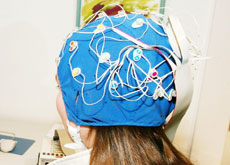Brain technology offers hope to disabled

Paralysis sufferers might one day be able to complete simple tasks, such as writing a letter, using brainpower alone.
Researchers in Switzerland are developing cutting-edge technology that uses human brainwaves to tell computers what to do.
Scientists at the Dalle Molle Institute for Perceptual Artificial Intelligence (Idiap) in canton Valais have been experimenting with ways of harnessing brainwaves via electrodes to send simple commands to a computer.
According to director Jean-Albert Ferrez, the institute has developed technology that can roughly identify what a person is thinking about, based on his or her mental activity.
“The computer can detect whether you are thinking about a calculation, a place, a colour or even what you want to eat for dinner,” he told swissinfo.
“But it’s not good enough yet to detect exactly what colour you’re thinking of.”
Mind reading
The process works by attaching electrodes to a patient’s scalp, which record the electromagnetic activity of the brain.
These electrical signals are sent to a “neuro-classifier” which is trained to recognise specific patterns of brain activity.
The computer then matches this activity to a corresponding task such as turning on a light or even writing a letter using an on-screen “virtual keyboard”.
“Through mental activity alone, a subject can select letters and write messages,” explained José Millan, a senior researcher at the institute.
Early days
The project is still in its experimental phase and, according to Ferrez, it could take years before practical applications are developed for the technology.
However, he believes the research might someday offer an unprecedented degree of autonomy to hundreds of thousands of severely disabled people, such as quadriplegics.
“This technology would be absolutely ideal for a person who is paralysed from the neck down,” said Ferrez.
“There are some prototypes that exist, which allow a wheelchair-user to guide the chair back and forth, or left and right, based on various brain activity, which is translated into commands which drive the computer.”
For the time being, the main focus of Idiap’s brain research is on helping physically disabled people; however, Millan predicts the technology will eventually find its way into everyday life.
“In the long term, we think this could be integrated with other forms of exchange, such as speech or movement, in order to make interaction between humans and machines, as well as between humans, more natural and direct,” he told swissinfo.
“There is nothing more direct than the act of thinking.”
Voice recognition
Idiap, which is affiliated with the Federal Institute of Technology in Lausanne and the University of Geneva, claims to be among the world’s top five centres conducting this type of research.
However, it is also well known for its pioneering work in other areas of perceptual artificial intelligence, such as speech recognition and authentication.
In November 2002, the institute was thrust into the media spotlight when it was asked to analyse a recording attributed to Osama bin Laden, which was broadcast on the Arabic television network, Al-Jeezera.
At the request of a French television station, Idiap analysed and compared the tape with over an hour of authenticated recordings of bin Laden’s voice, as well as other Arabic speakers.
Idiap eventually concluded that the November recording was not genuine and that it was “difficult to agree with some United States officials” who claimed it was bin Laden’s voice.
Smart meetings
From speech recognition to brainwaves, nearly all of Idiap’s research is aimed at facilitating human interaction with each other and with technology.
Another area of the institute’s work involves “multimodal information processing”, which focuses specifically on teaching computers how to interpret human actions, such as speech, touch and movement.
The group is currently working with the National Centre of Competence in Research to develop applications for this technology, such as archiving data and sound files.
It has also set up a “smart meeting room”, equipped with a state-of-the-art video and audio recording system.
According to Ferrez, three cameras and 24 strategically-placed microphones give the room “added intelligence”.
“We can do very interesting things like localising where a sound comes from, which helps us identify who is speaking at any given time,” he said. “This is very useful in terms of speech and object recognition and motion detection.”
Ultimately, he believes this type of data acquisition will make meetings more efficient by automating and accelerating processes such as minute-taking, voting and remote conferencing.
“All of this technology goes in the direction of creating a tool… to help people conduct meetings, and remember and analyse what is said.”
swissinfo, Anna Nelson in Geneva
Idiap is located in Martigny and employs approximately 60 Swiss and foreign scientists.
It specialises in voice recognition, machine learning and “multimodal information processing”.
Last autumn, the group began examining ways of using brainwaves to carry out simple tasks via computer.
Idiap is among the world’s top five institutes conducting this type of brain research.
Idiap gained recognition in November for its analysis of an audiotape, attributed to Saudi extremist Osama bin Laden.

In compliance with the JTI standards
More: SWI swissinfo.ch certified by the Journalism Trust Initiative


You can find an overview of ongoing debates with our journalists here. Please join us!
If you want to start a conversation about a topic raised in this article or want to report factual errors, email us at english@swissinfo.ch.